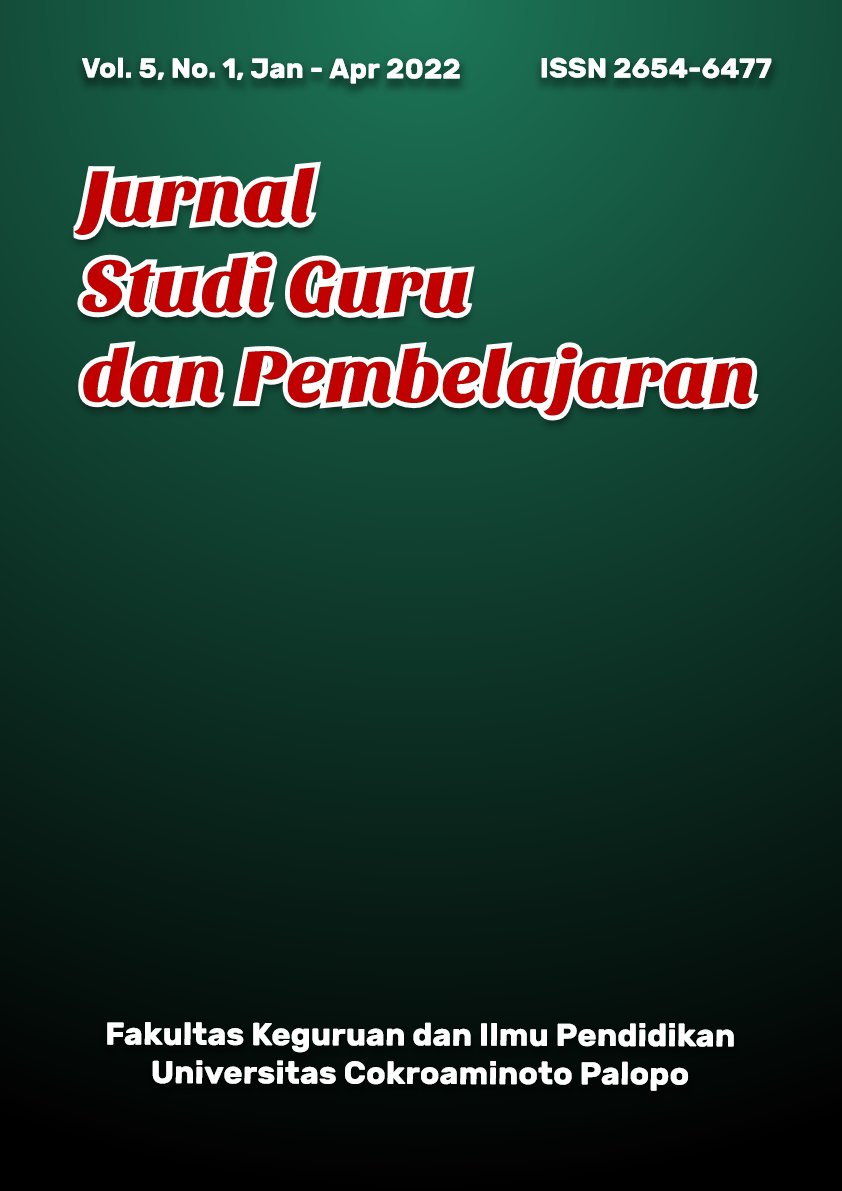Analysis of Generic Structure and Recount Text Understanding in Eighth Grade Students
DOI:
https://doi.org/10.30605/jsgp.5.1.2022.1403Keywords:
Communication, Recount Text, UnderstandingAbstract
This research is motivated by many challenges faced and often occur when learning online during a pandemic like this. Many of the schools where I conduct teaching and learning activities have experienced the same problem, namely, students' inability to comprehend the material and limited communication between teachers and students. My goal in carrying out this activity at the junior high school where I teach, particularly in English subjects, is to make lessons more enjoyable and understandable for students. The method I employ is to provide material in the form of a video that incorporates animation with the goal of increasing students' interest in seeing the material, particularly the Recount Text material. Many students continue to struggle with the material they have been given, and some students are less careful in completing the assignments they have been given
Downloads
References
Aiman, U., & Fitrawati, F. (2019). An Analysis on the Second Year Students’ Difficulties in Comprehending Recount Text at SMPN 27 Padang. Journal of English Language Teaching, 8(3), 317-326.
Apsari, Y. (2017). The use of picture series in teaching writing recount text. ELTIN JOURNAL: Journal of English Language Teaching in Indonesia, 5(2), 51-56 DOI: https://doi.org/10.22460/eltin.v5i2.p51-56
Atmowardoyo, H. (2018). Research methods in TEFL studies: Descriptive research, case study, error analysis, and R & D. Journal of Language Teaching and Research, 9(1), 197–204. DOI: https://doi.org/10.17507/jltr.0901.25
Cakrawati, L. M. (2018). Recount text in SFL perspective: Pedagogical implication based on student’s writing analysis. Register Journal, 11(2), 210-227. DOI: https://doi.org/10.18326/rgt.v11i2.210-227
Creswell. (2012). Qualitative Inquiry & Research Design.
Creswell, J. W., & Poth, C. N. (2016). Qualitative inquiry and research design: Choosing among five approaches. Sage publications.
Dastgeer, G., & Afzal, M. T. (2015). Improving English writing skill: A case of problem-based learning. American Journal of Educational Research, 3(10), 1315–1319.
Hartiwi, A., Sutisna, E., & Kurniati, N. U. S. (2018). The Use of Mind Mapping Technique on Students Ability To Write A Recount Text. JETLi| Journal of English Language Teaching and Linguistics Studies, 1(1). DOI: https://doi.org/10.55215/jetli.v1i1.1487
Hendrawati, N. (2018). An analysis on students’ errors in writing sentence patterns. Loquen: English Studies Journal, 11(1), 63–85. DOI: https://doi.org/10.32678/loquen.v11i01.1036
Hidayasari, C. N. (2020). An Error Analysis of Students Grammatical Error in Writing Report Text Based on Surface Strategy Taxonomy At The Fourth Semester Of English Education Department State Institute For Islamic Studies (Iain Salatiga).
Husna, A., & Multazim, A. (2019). Students Difficulties In Writing Recount Text at Inclusion Classes. LET: Linguistics, Literature and English Teaching Journal, 9(1), 52–76. DOI: https://doi.org/10.18592/let.v9i1.3077
Jabbarova, A., & Jabbarov, U. (2020). Methods of Improvement of Writing. Архив Научных Публикаций JSPI.
Noprianto, E. (2017). Student’s Descriptive text writing in SFL perspectives. IJELTAL (Indonesian Journal of English Language Teaching and Applied Linguistics), 2(1), 65-81. DOI: https://doi.org/10.21093/ijeltal.v2i1.53
Perri, R. L., Spinelli, D., & Di Russo, F. (2017). Missing the target: the neural processing underlying the omission error. Brain Topography, 30(3), 352–363. DOI: https://doi.org/10.1007/s10548-017-0545-3
Ramli, D., Suhartono, L., & Novita, D. (2013). An Analysis on The Students Error In Writing Recount Text. Jurnal Pendidikan Dan Pembelajaran Khatulistiwa, 2(2).
Sari, M. K. (2017). An analysis of students’ problem in writing recount text. Jurnal Educative: Journal of Educational Studies, 2(1), 14-21.
Sayukti, N. K. H., & Kurniawan, E. (2018). An analysis of student’s recount text in systemic functional linguistic perspectives. RETORIKA: Jurnal Ilmu Bahasa, 4(1), 53–59. DOI: https://doi.org/10.22225/jr.4.1.466.53-59
Syamsuri, A. S., Muhsin, M. A., & Nurmayani, N. (2016). The effectiveness of caricature media in learning the writing of argumentative paragraphs. Theory and Practice in Language Studies, 6(11), 2079–2086. DOI: https://doi.org/10.17507/tpls.0611.03
Downloads
Published
How to Cite
Issue
Section
License
In submitting the manuscript to the journal, the authors certify that:
- They are authorized by their co-authors to enter into these arrangements.
- The work described has not been formally published before, except in the form of an abstract or as part of a published lecture, review, thesis, or overlay journal.
- That it is not under consideration for publication elsewhere,
- That its publication has been approved by all the author(s) and by the responsible authorities – tacitly or explicitly – of the institutes where the work has been carried out.
- They secure the right to reproduce any material that has already been published or copyrighted elsewhere.
- They agree to the following license and copyright agreement.
License and Copyright Agreement
Authors who publish with JSGP agree to the following terms:
- Authors retain copyright and grant the journal right of first publication with the work simultaneously licensed under Creative Commons Attribution License (CC BY-SA 4.0) that allows others to share the work with an acknowledgement of the work's authorship and initial publication in this journal.
- Authors are able to enter into separate, additional contractual arrangements for the non-exclusive distribution of the journal's published version of the work (e.g., post it to an institutional repository or publish it in a book), with an acknowledgement of its initial publication in this journal.
- Authors are permitted and encouraged to post their work online (e.g., in institutional repositories or on their website) prior to and during the submission process, as it can lead to productive exchanges, as well as earlier and greater citation of published work.














